Experimental Research Regarding the Effect of Mineral Aggregates on the Wear of Mixing Blades of Concrete Mixers
Abstract
:1. Introduction
2. Materials and Methods
2.1. Chemical Composition and Hardness of the Studied Samples
2.2. Determination of Microgeometrical Parameters of the Samples
2.3. Description of the Experimental Method
2.4. Theoretical Method Used to Confirm the Experimental Results
3. Results
3.1. Experimental Method
| Duration of Operation, (min) | Sample Mass during Experiment; Mass Loss; Δm; Respectively, ΣΔm; (g) | |||||
|---|---|---|---|---|---|---|
| Blade 1 | Blade 2 | Blade 3 | ||||
| 0 | 55.5200 | 0 | 54.7568 | 0 | 70.4701 | 0 |
| 60 | (Figure 13a) 55.4684 | 0.0516 | 54.7399 | 0.0169 | 70.4297 | 0.0404 |
| 0.0516 | 0.0169 | 0.0404 | ||||
| 120 | (Figure 13b) 55.4392 | 0.0808 | 54.7246 | 0.0322 | 70.3876 | 0.0825 |
| 0.0292 | 0.0153 | 0.0421 | ||||
| 180 | 55.4177 | 0.1023 | 54.7040 | 0.0528 | 70.3435 | 0.1266 |
| 0.0215 | 0.0206 | 0.0441 | ||||
| 240 | 55.3970 | 0.123 | 54.6790 | 0.0778 | 70.2913 | 0.1788 |
| 0.0207 | 0.0250 | (Figure 13d) 0.0522 | ||||
| 300 | 55.3731 | 0.1469 | (Figure 13c) 54.6527 | 0.1041 | 70.2330 | 0.2371 |
| 0.0239 | 0.0263 | 0.0583 | ||||
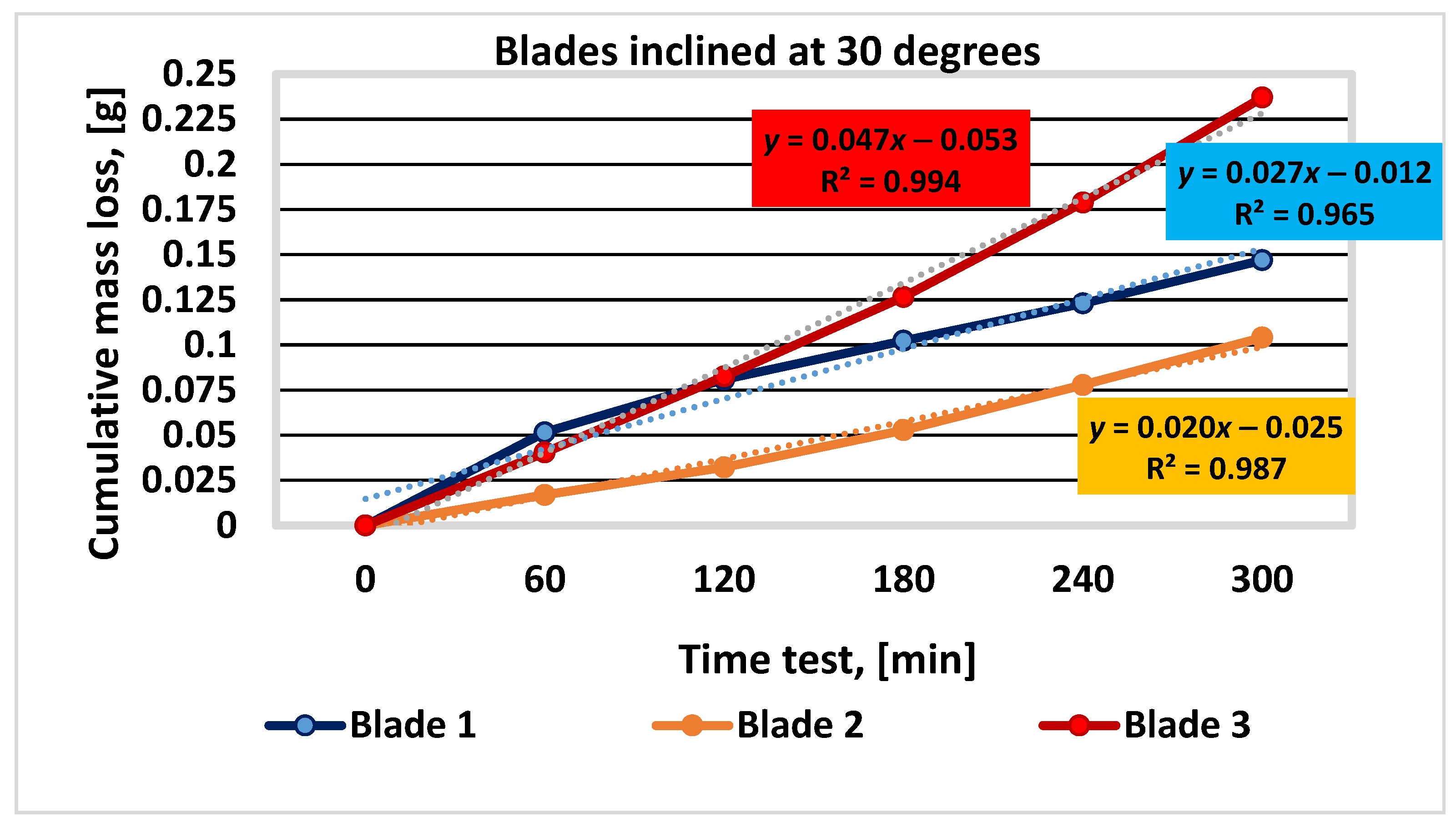
| Duration of Operation, (min) | Sample Mass during Experiment; Mass Loss; Δm; Respectively, ΣΔm; (g) | |||||
|---|---|---|---|---|---|---|
| Blade 1 | Blade 2 | Blade 3 | ||||
| 0 | 55.3731 | 0 | 53.3737 | 0 | 69.7735 | 0 |
| 60 | 55.3408 | 0.0323 | 53.3507 | 0.0230 | 69.7360 | 0.0375 |
| 0.0323 | 0.0230 | 0.0375 | ||||
| 120 | 55.3098 | 0.0633 | 53.3313 | 0.0424 | 69.7051 | 0.0684 |
| 0.0310 | 0.0194 | 0.0309 | ||||
| 180 | 55.2814 | 0.0917 | 53.3100 | 0.0637 | 69.6683 | 0.1052 |
| 0.0284 | 0.0213 | 0.0368 | ||||
| 240 | 55.2556 | 0.1175 | 53.2967 | 0.077 | 69.6299 | 0.1436 |
| 0.0258 | 0.0133 | 0.0384 | ||||
| 300 | 55.2282 | 0.1449 | 53.2768 | 0.0969 | 69.5849 | 0.1886 |
| 0.0274 | 0.0199 | 0.0450 | ||||

| Duration of Operation, (min) | Sample Mass during Experiment; Mass Loss; Δm; Respectively, ΣΔm; (g) | |||||
|---|---|---|---|---|---|---|
| Blade 1 | Blade 2 | Blade 3 | ||||
| 0 | 54.3974 | 0 | 54.6199 | 0 | 70.2322 | 0 |
| 60 | 54.3709 | 0.0265 | 54.6093 | 0.0106 | 70.1795 | 0.0186 |
| 0.0265 | 0.0106 | (Figure 13f) 0.0527 * 0.0186 | ||||
| 120 | 54.3467 | 0.0507 | 54.5925 | 0.0274 | 70.1387 | 0.0594 |
| 0.0242 | 0.0168 | 0.0408 | ||||
| 180 | 54.3263 | 0.0711 | 54.5794 | 0.0405 | 70.1055 | 0.0926 |
| 0.0204 | 0.0131 | 0.0332 | ||||
| 240 | 54.3135 | 0.0839 | 54.5642 | 0.0557 | 70.0672 | 0.1309 |
| 0.0128 | 0.0152 | 0.0383 | ||||
| 300 | (Figure 13e) 54.2958 | 0.1016 | 54.5531 | 0.0668 | 70.0324 | 0.1657 |
| 0.0177 | 0.0111 | (Figure 13g) 0.0348 | ||||
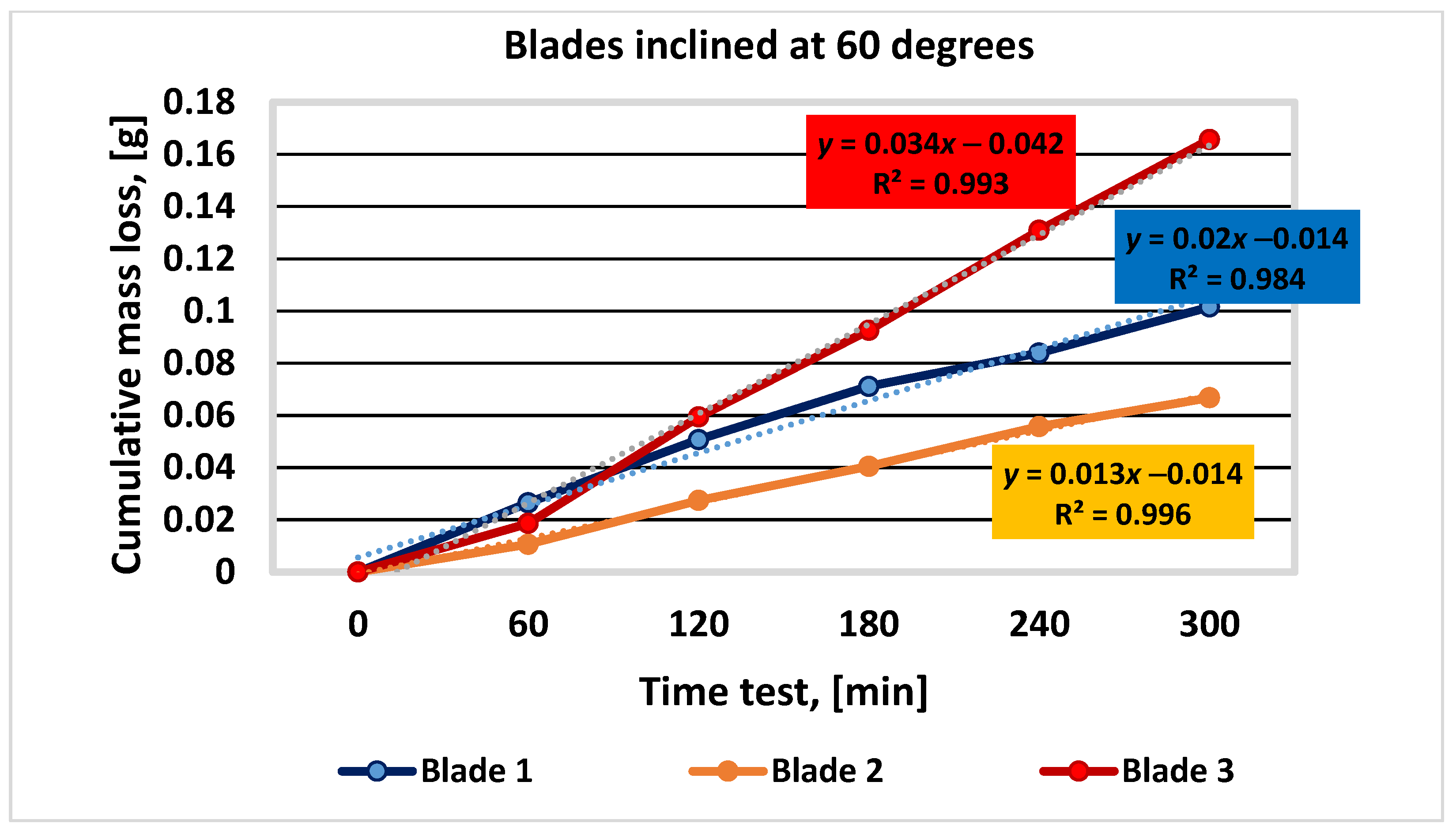

3.2. Theoretical Method
4. Discussion
5. Conclusions
- ✓
- The analytical calculation regarding the influence of the inclination angle and the sliding frictional coefficient between the aggregate material and the blade—on the ratio between the frictional force (manifested on the surface of the mixing blade) and the weight of the aggregate material that loads the blade during operation—suggests that modifying the inclination angle can have a significant impact on the frictional forces experienced by the mixing blade during mixing;
- ✓
- When the angle of inclination is increased, the relative contribution of frictional forces to the overall load on the mixing blade decreases, indicating a potential reduction in wear and mechanical stresses on the mixer components. Moreover, the effect is more substantial when the sliding frictional coefficient between the aggregate material and the mixing blade is higher, emphasizing the importance of considering material properties and surface interactions in mixer design and operation. Overall, these results highlight the potential benefits of optimizing the angle of inclination in mixer blade design to minimize frictional forces and improve the longevity and performance of the mixer in handling aggregate materials with varying frictional characteristics;
- ✓
- The experimental results (graphically represented in Figure 10, Figure 11 and Figure 12) confirm and are in full agreement with the observations reported in the paper [1], which presents a wear test method using the Baroid tribometer. According to these results, mixing blade no. 2 with 26% Cr exhibits the best wear resistance among the tested mixing blades, while mixing blade no. 1 (with 4% Cr) performs better than mixing blade no. 3 (with 9% Cr). These conclusions are consistent with the results mentioned in paper [1]. In addition, the results specified in this paper demonstrate that this behavior of the materials is maintained under the conditions of different inclination angles of the mixing blades. This conclusion superimposed on the effect of inclination angle can provide important information for choosing the best technical solution for the concrete-mixer design;
- ✓
- Regarding the chemical composition of the mixing-blade materials, it can be stated (in accordance with the assessments from [1]) that the chromium content plays a significant role in determining the wear behavior of the three types of cast iron;
- ✓
- According to reference [26], cast irons with chromium percentages above 10% show increased wear resistance. The typical range of Cr content assumed in the formulas for such cast irons is 10–35%, being in accordance with the experimental results obtained for mixing blade no. 2;
- ✓
- In industrial applications related to the production of cement concrete, it is advisable to use cast iron with either 25% Cr or 4% Cr. The choice of the intermediate grade (9% Cr) is not justified due to the higher cost and inferior performance compared to the 4% Cr version. Detailed explanations are given in [1];
- ✓
- Additionally, the design and construction aspects demonstrating (in accordance with the experimental results) that increasing the angle of inclination of the mixing blades relative to the shaft axis leads to decreased cumulative mass loss and improved wear resistance for all mixing blades must be considered;
- ✓
- As the angle of inclination of the mixing blades increases, erosive wear becomes predominant, accelerating the phenomenon of mechanical degradation of the samples. When choosing the right angle of inclination of the mixing blades, the mixing efficiency ensured by the position of the mixing blades must also be taken into account [14]. In this way, by using the observations related to the materials used for the mixing blades, the angle of inclination of the mixing blades, and the efficiency of the mixing process, optimal solutions can be found for the design and manufacture of concrete mixers;
- ✓
- The method proposed by the authors can be recommended for the study of wear phenomena in similar industrial equipment.
Author Contributions
Funding
Institutional Review Board Statement
Informed Consent Statement
Data Availability Statement
Conflicts of Interest
References
- Niță, A.; Petrescu, M.G.; Dumitru, T.; Burlacu, A.; Tănase, M.; Laudacescu, E.; Ramadan, I. Experimental research on the wear behavior of materials used for manufacturing components of cement concrete mixers. Materials 2023, 16, 2326. [Google Scholar] [CrossRef] [PubMed]
- Cazacliu, B. In–mixer measurements for describing mixture evolution during concrete mixing. Chem. Eng. Res. Des. 2008, 86, 1423–1433. [Google Scholar]
- Ferraris, C.F. Concrete Mixing Methods and Concrete Mixers: State of the Art. J. Res. Natl. Inst. Stand. Technol. 2001, 106, 391–399. [Google Scholar] [PubMed]
- Stel’makh, S.A.; Shcherban, E.M.; Shuiskii, A.I.; Prokopov, A.Y.; Madatyan, S.M.; Parinov, I.A.; Cherpakov, A.V. Effects of the Geometric Parameters of Mixer on the Mixing Process of Foam Concrete Mixture and Its Energy Efficiency. Appl. Sci. 2020, 10, 8055. [Google Scholar]
- Valigi, M.C.; Logozzo, S.; Landi, L.; Braccesi, C.; Galletti, L. Twin–Shaft Mixers’ Mechanical Behavior Numerical Simulations of the Mix and Phases. Machines 2019, 7, 39. [Google Scholar] [CrossRef] [Green Version]
- Labiapari, W.S.; Gonçalves, R.J.; de Alcantara, C.M.; Pagani, V.; Di Cunto, J.C.; de Mello, J.D.B. Understanding Abrasion–Corrosion to Improve Concrete Mixer Drum Performance: A Laboratory and Field Approach. Wear 2021, 477, 203830. [Google Scholar]
- Fasano, J.; Janz, E.; Myers, K. Design Mixers to Minimize Effects of Erosion and Corrosion Erosion. Int. J. Chem. Eng. 2012, 2012, 171838. [Google Scholar] [CrossRef] [Green Version]
- Sapate, S.G.; RamaRao, A.V. Effect of Erodent Particle Hardness on Velocity Exponent in Erosion of Steels and Cast Irons. Mater. Manuf. Process. 2003, 18, 783–802. [Google Scholar] [CrossRef]
- Stack, M.; Stott, F.; Wood, G. The significance of velocity exponents in identifying erosion–corrosion mechanisms. J. Phys. IV Colloq. 1993, 3, C9-687–C9-694. [Google Scholar] [CrossRef] [Green Version]
- Khalid, Y.A.; Sapuan, S.M. Wear analysis of centrifugal slurry pump impellers. Ind. Lubr. Tribol. 2007, 59, 18–28. [Google Scholar] [CrossRef]
- Lopez, D.; Congote, J.P.; Cano, J.R.; Toro, A.; Tschiptschin, A.P. Effect of particle velocity and impact angle on the corrosion–erosion of AISI 304 and AISI 420 stainless steels. Wear 2005, 259, 118–124. [Google Scholar] [CrossRef]
- Braccesi, C.; Landi, L. An analytical model for force estimation on arms of concrete mixers. In Proceedings of the ASME Design Engineering Technical Conference, San Diego, CA, USA, 30 August–2 September 2009. [Google Scholar]
- Valigi, M.C.; Gasperini, I. Planetary Vertical Concrete Mixers: Simulation and Predicting Useful Life in Steady States and in Perturbed Conditions. Simul. Model. Pract. Theory 2007, 15, 1211–1223. [Google Scholar]
- Zhang, H.; Feng, P.; Ying, W. Abrasive wear and optimal installation angle of concrete double–horizontal shaft mixer stirring blades. SN Appl. Sci. 2020, 2, 1067. [Google Scholar] [CrossRef]
- Yao, Z.; Yang, R.; Yuan, W.; An, H. Mechanical Analysis and Optimal Design of Mixing Paddles forcsam Mixers. Acad. J. Manuf. Eng. 2019, 17, 80–86. [Google Scholar]
- Khidir, T.C. Designing, Remodeling and Analyzing the Blades of Portable Concrete Mixture. Int. J. Mech. Eng. Robot. Res. 2018, 7, 674–678. [Google Scholar] [CrossRef]
- Jungedal, M. Mild Impact Wear in a Concrete Mixer, an Evaluation of Wet Abrasive Wear. Master’s Thesis, Royal Institute of Technology Department of Material Science and Engineering SE–100 44, Stockholm, Sweden, 2012. [Google Scholar]
- Valigi, M.C.; Logozzo, S.; Rinchi, M. Wear resistance of blades in planetary concrete mixers. Design of a new improved blade shape and 2D validation. Tribol. Int. 2016, 96, 191–201. [Google Scholar] [CrossRef]
- Valigi, M.C.; Logozzo, S.; Rinchi, M. Wear resistance of blades in planetary concrete mixers. Part II: 3D validation of a new mixing blade design and efficiency evaluation. Tribol. Int. 2016, 103, 37–44. [Google Scholar]
- Valigi, M.C.; Fabi, L.; Gasperini, I. Wear resistance of new blade for planetary concrete mixer. In Proceedings of the 5th World Tribology Congress, WTC 2013, Torino, Italy, 8–13 September 2013. [Google Scholar]
- Valigi, M.C.; Logozzo, S.; Gasperini, I. Study of wear of planetary concrete mixer blades using a 3D optical scanner. In Proceedings of the International Mechanical Engineering Congress & Exposition, IMECE2015, Houston, TX, USA, 13–19 November 2015. [Google Scholar]
- Trejo, D.; Prasittisopin, L. Effects of Mixing Variables on Early-Age Characteristics of Portland Cement Systems. J. Mater. Civ. Eng. 2016, 28, 04016094. [Google Scholar] [CrossRef]
- Prasittisopin, L.; Trejo, D. Effects of Mixing Variables on Hardened Characteristics of Portland Cement Mortars. ACI Mater. J. 2015, 112, 399–408. [Google Scholar] [CrossRef]
- Sereewatthanawut, I.; Panwisawas, C.; Ngamkhanong, C.; Prasittisopin, L. Effects of Extended Mixing Processes on Fresh, Hardened and Durable Properties of Cement Systems Incorporating Fly Ash. Sci. Rep. 2023, 13, 6091. [Google Scholar] [CrossRef]
- Hafeez, F.; Ahmed, N.; Ali, M.A.; Farooq, M.U.; AlFaify, A.Y.; Rehman, A.U. A Comprehensive Efficiency Evaluation of Conventional and Ablation Sand Casting on the Example of the AlSi7Mg Alloy Impeller. Int. J. Adv. Manuf. Technol. 2022, 121, 3653–3672. [Google Scholar] [CrossRef]
- Zheng, B.; Xing, J.; Li, W.; Tu, X.; Jian, Y. Effect of chromium–induced (Fe, Cr)3C toughness improvement on the two–body abrasive wear behaviors of white cast iron. Wear 2020, 456–457, 203363. [Google Scholar] [CrossRef]
- Callister, W.; Rethwisch, D. Materials Science and Engineering: An Introduction, 10th ed.; Wiley: Hoboken, NJ, USA, 2018. [Google Scholar]
- Lai, H.; Hsieh, C.; Lin, C.; Wu, W. Characteristics of Eutectic α(Cr,Fe)–(Cr,Fe)23C6 in the Eutectic Fe–Cr–C Hardfacing Alloy. Metall. Mater. Trans. A 2017, 48, 493–500. [Google Scholar] [CrossRef]
- Kagawa, A.; Okamoto, T. Hot hardness of (Fe, Cr)3C and (Fe, Cr)TC3 carbides. J. Mater. Sci. 1984, 19, 2546–2554. [Google Scholar] [CrossRef]
- Dangar, S.; Sen, A.; Mukherjee, S. Optimization of Surface Roughness Parameters through Regression Model Analysis. Int. J. Eng. Res. Technol. 2014, 3, 6. [Google Scholar]
- ISO 4287:1997; Geometrical Product Specifications (GPS)—Surface Texture: Profile Method—Terms, Definitions and Surface Texture Parameters. ISO: Geneva, Switzerland, 1997.
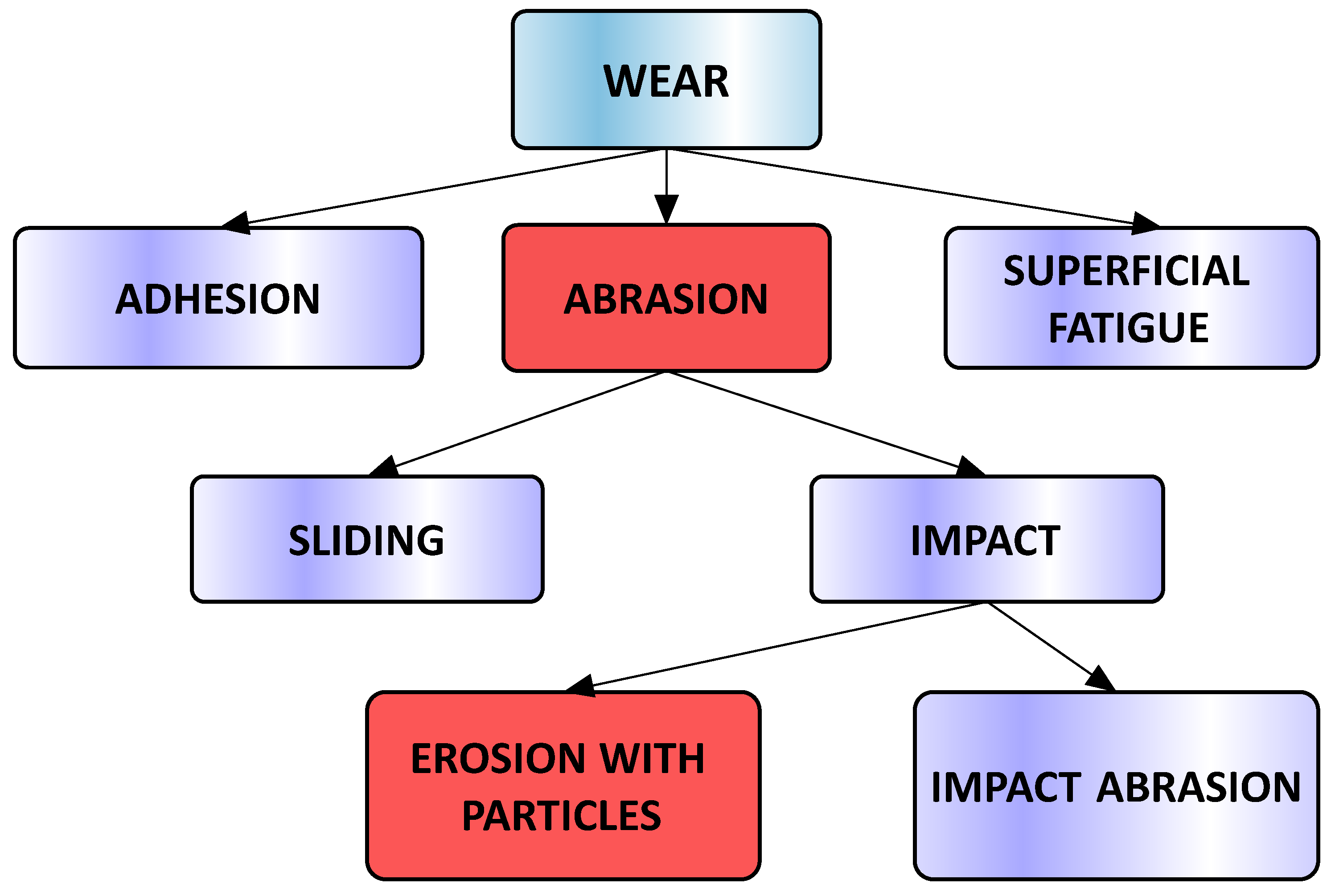
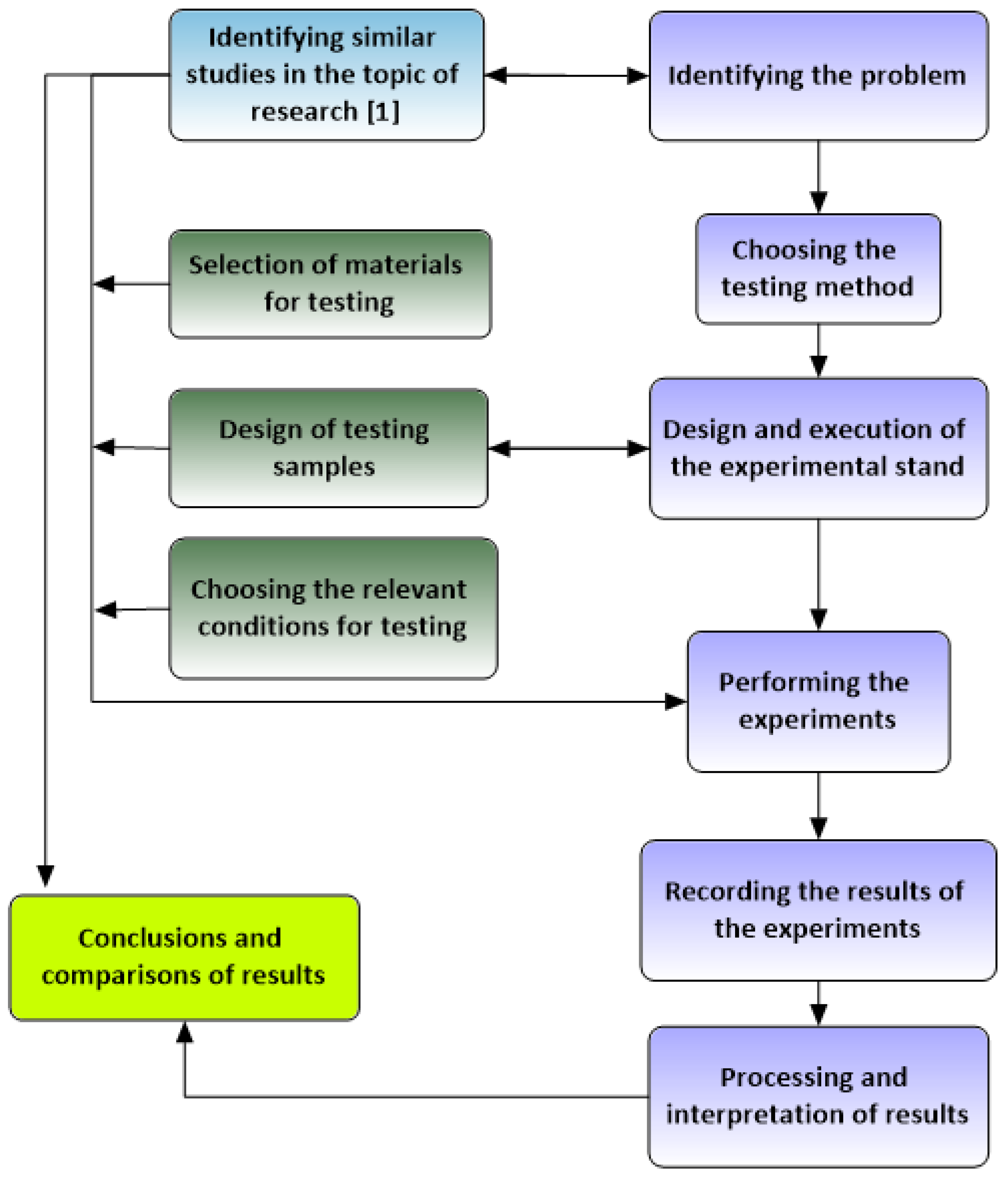




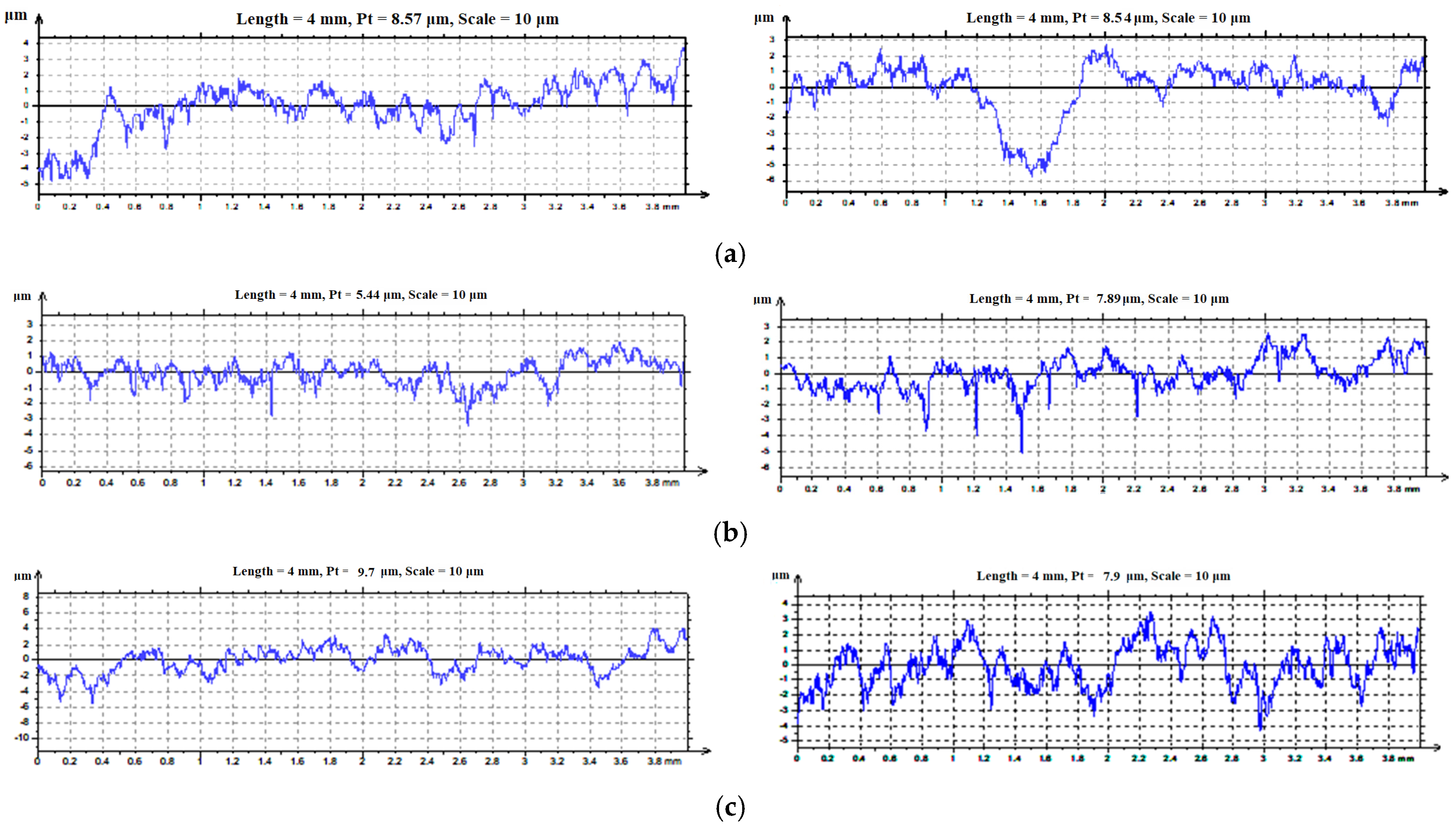

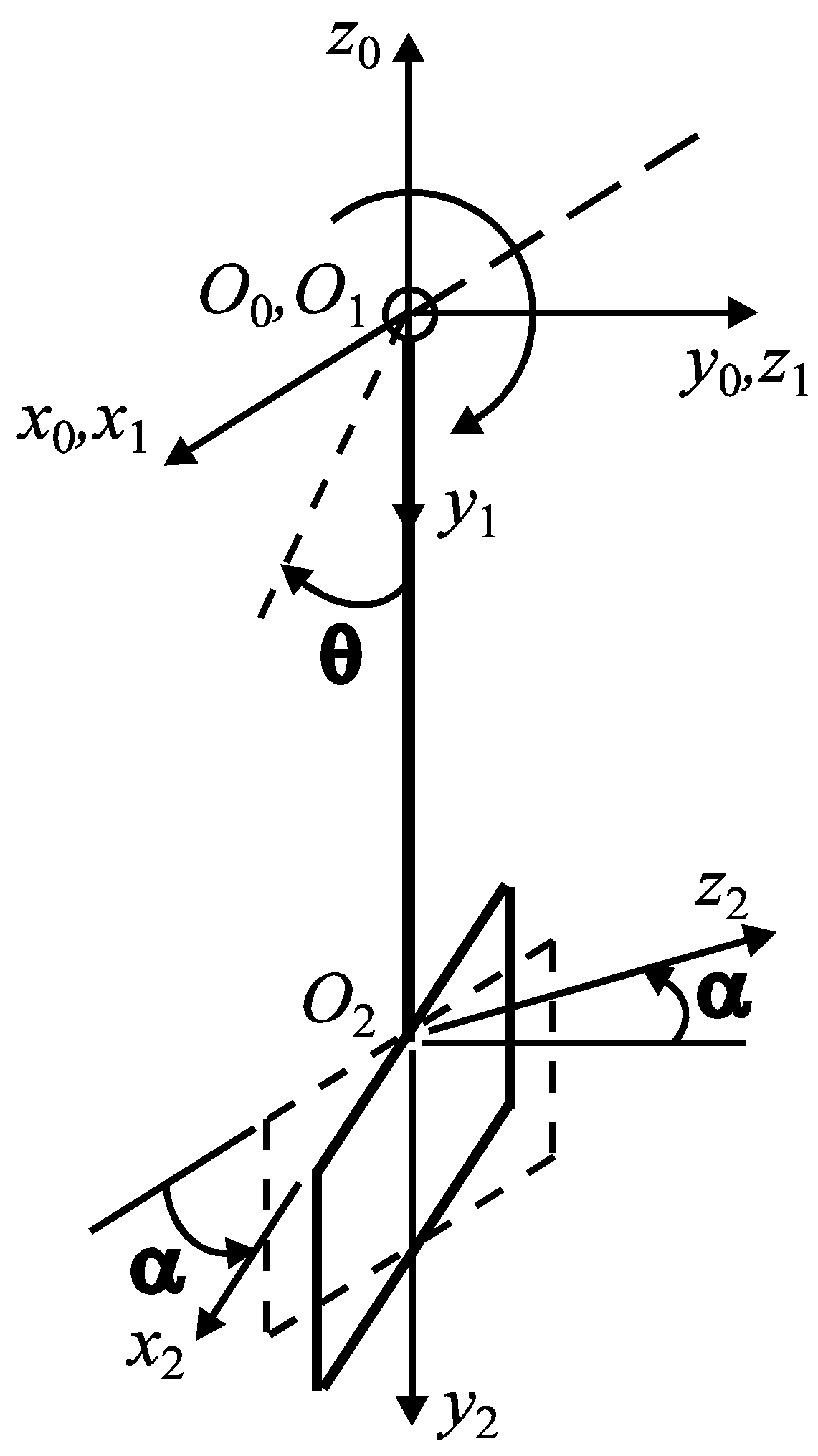
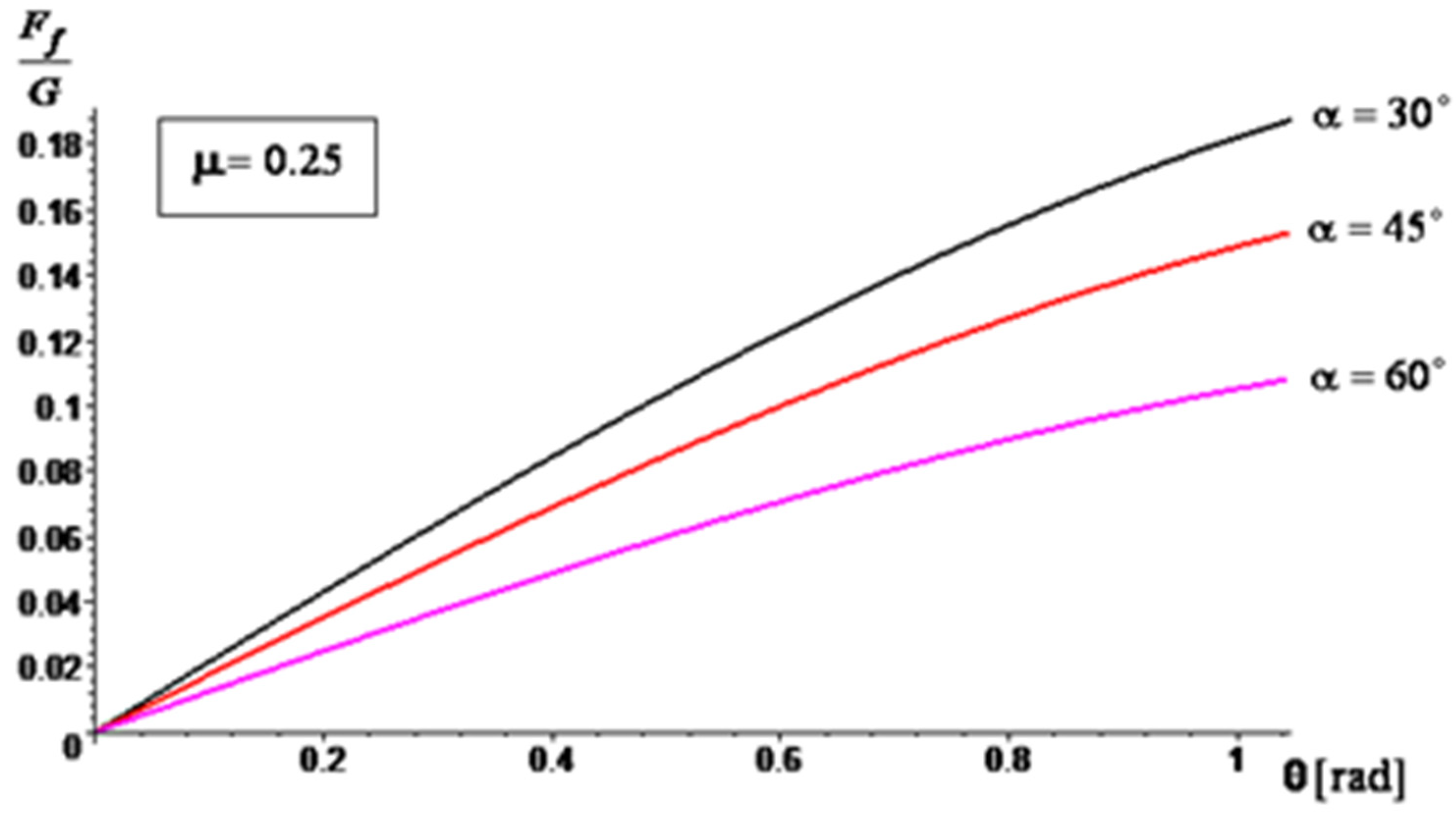
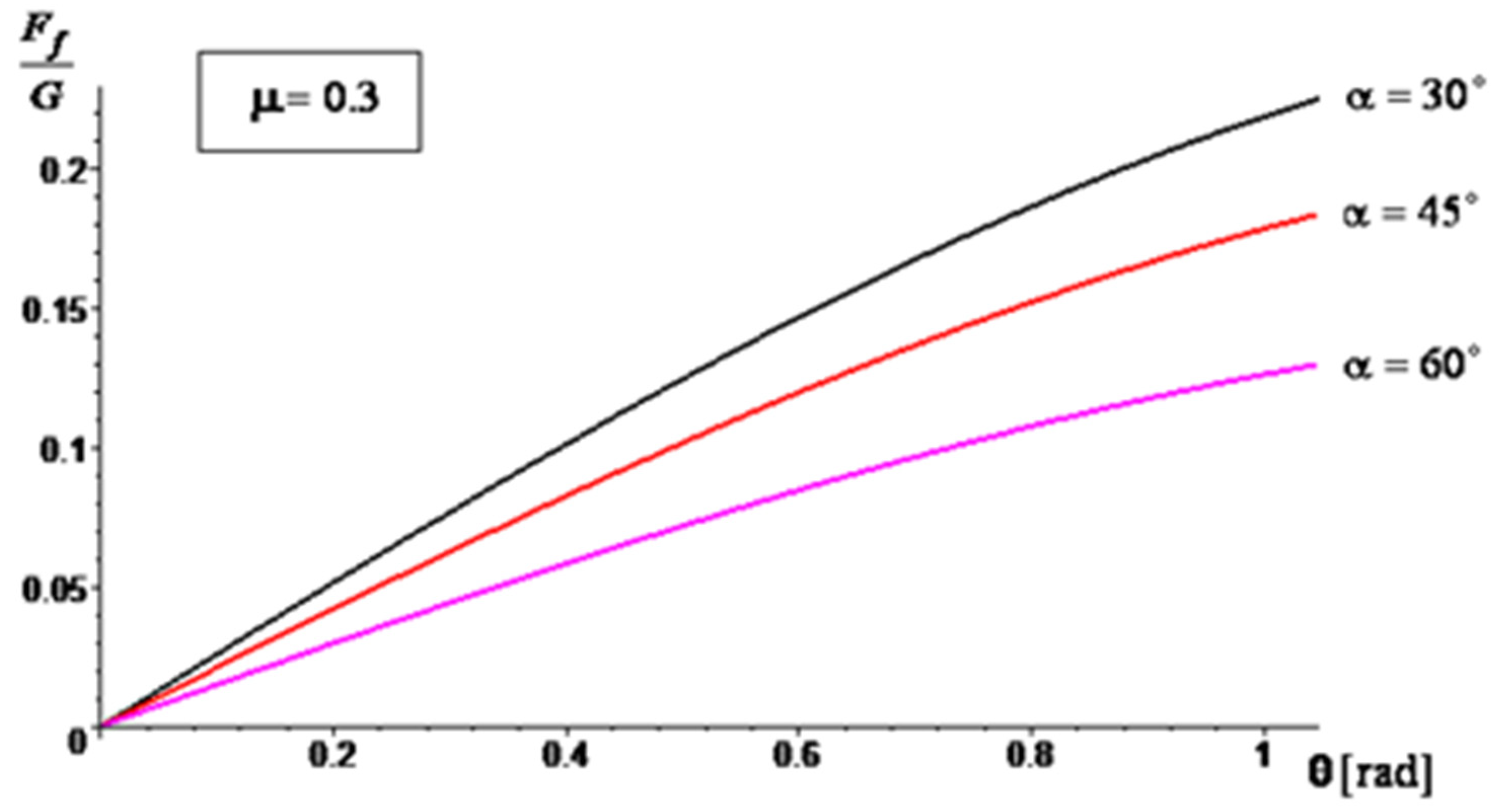
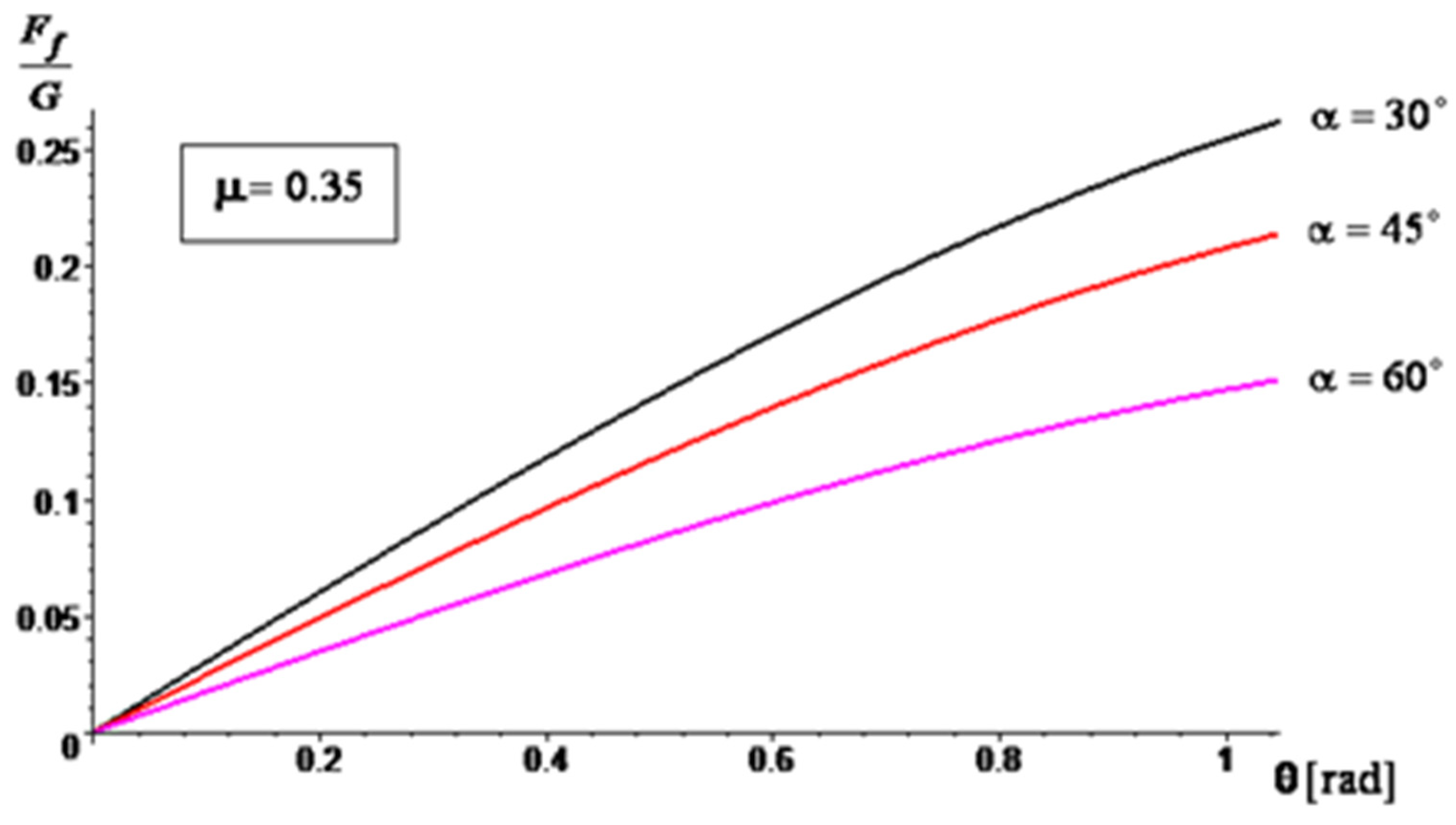
| Sample | Chemical Composition, % | ||||||||
|---|---|---|---|---|---|---|---|---|---|
| C | Si | P | S | Cr | Mn | Fe | Ni | Mo | |
| 1 | 3.28 | 0.76 | 0.07 | 0.03 | 3.83 | 1.10 | 89.86 | 0.89 | 0.20 |
| 2 | 3.72 | 0.74 | 0.02 | 0.04 | 25.65 | 0.87 | 68.19 | 0.040 | 0.35 |
| 3 | 3.08 | 0.96 | 0.04 | 0.03 | 9.77 | 1.14 | 84.12 | 0.35 | 0.49 |
| Value of Tilt-Angle Blade Relative to the Axis of Rotation, (Degrees) | Blade—Cast Iron 1 HV0.2 | Blade—Cast Iron 2 HV0.2 | Blade—Cast Iron 3 HV0.2 | |||
|---|---|---|---|---|---|---|
| Unworn Sample | Worn Sample | Unworn Sample | Worn Sample | Unworn Sample | Worn Sample | |
| 30 | 464.654, value from [1] | 1191 | 1228.505, value from [1] | 911 | 632.9904, value from [1] | 676.5 |
| 45 | 1237 | 1029 | 936.5 | |||
| 60 | 1320 | 1260.5 | 1177 | |||
| Sample/Sample Face | 1A | 1B | 2A | 2B | 3A | 3B |
|---|---|---|---|---|---|---|
| Roughness value Ra, μm | 0.555 | 0.569 | 0.452 | 0.528 | 0.810 | 0.805 |
Disclaimer/Publisher’s Note: The statements, opinions and data contained in all publications are solely those of the individual author(s) and contributor(s) and not of MDPI and/or the editor(s). MDPI and/or the editor(s) disclaim responsibility for any injury to people or property resulting from any ideas, methods, instructions or products referred to in the content. |
© 2023 by the authors. Licensee MDPI, Basel, Switzerland. This article is an open access article distributed under the terms and conditions of the Creative Commons Attribution (CC BY) license (https://creativecommons.org/licenses/by/4.0/).
Share and Cite
Niță, A.; Laudacescu, E.; Petrescu, M.G.; Dumitru, T.; Burlacu, A.; Bădoiu, D.G.; Tănase, M. Experimental Research Regarding the Effect of Mineral Aggregates on the Wear of Mixing Blades of Concrete Mixers. Materials 2023, 16, 5047. https://doi.org/10.3390/ma16145047
Niță A, Laudacescu E, Petrescu MG, Dumitru T, Burlacu A, Bădoiu DG, Tănase M. Experimental Research Regarding the Effect of Mineral Aggregates on the Wear of Mixing Blades of Concrete Mixers. Materials. 2023; 16(14):5047. https://doi.org/10.3390/ma16145047
Chicago/Turabian StyleNiță, Adrian, Eugen Laudacescu, Marius Gabriel Petrescu, Teodor Dumitru, Andrei Burlacu, Dorin George Bădoiu, and Maria Tănase. 2023. "Experimental Research Regarding the Effect of Mineral Aggregates on the Wear of Mixing Blades of Concrete Mixers" Materials 16, no. 14: 5047. https://doi.org/10.3390/ma16145047





